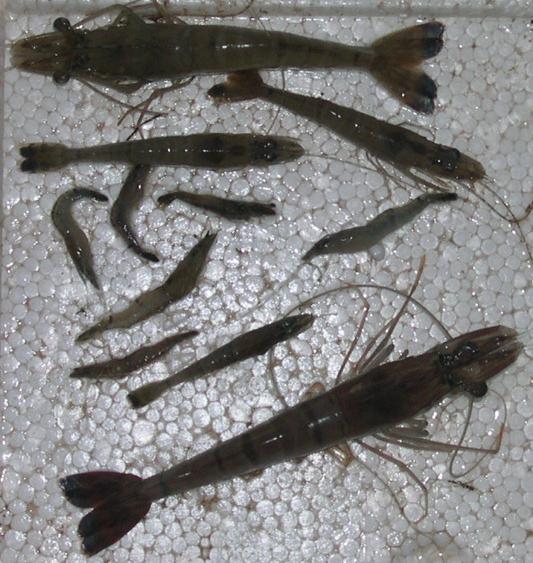CAUSES
The causative agent of MBV (Monodon Baculovirus) is a type A virus called Baculovirus monodon, the nuclear structure (nucleoic acid) is dsDNA, enveloped, rod-shaped. According to J.Mari and CTV, 1993, the MBV strain of black tiger shrimp from the Indian Pacific has a core size of 42 ± 3 x 246 ± 15 nm, envelope size 75 ± 4 x 324 ± 33 nm. The PMV strain of shrimp (P.plebejus, P. monodon, P. merguiensis) from Australia has nucleus size 45-52 x 260-300 nm, envelope size 60 x 420 nm.
Parasitic virus in hepatopancreatic epithelial cells (Hepatopancreas) and epidermal cells anterior midgut, the virus reproduces inside the nucleus of animal cells, including the following stages:
- Stage 0 (latent): After the cell is infected with MBV, the early stage of cytoplasm changes.
- Stage 1: The nucleus of the cell is slightly swollen, the chromosomes dissolve and move closer to the nuclear membrane. The cytoplasm gradually loses their function and forms fat droplets. The virus begins to take effect.
- Stage 2: The nucleus swells rapidly, the number of viruses increases rapidly, and occlusion bodies appear in the nucleus.
- Stage 3: diseased cells, 2 times increase in nucleus, normal diameter and 6 times increase in volume. Inside the nucleus there are 1 to many hidden bodies, which are full of viruses. Viruses destroy host cells, continue to migrate to other cells or follow excretions into the environment, forming free viruses that persist in mud and water.
SYMPTOMS:
When shrimp are newly infected with MBV virus, disease signs are not obvious. When shrimp are seriously infected and sick, they often show some of the following signs:
- Shrimp are dark or pale green, dark green. Shrimp have poor appetite, weak activity, and slow growth (slow growth).
- The appendages and chitin shell are necrotic, with many attachment organisms (protozoan parasites, algae, and filamentous bacteria).
- Hepatopancreas atrophy has a slightly white area, rots very quickly.
- Cumulative mortality, as high as 70% or possibly most shrimp in the pond.

Distribution:
MBV was first detected in 1980 in a herd of Giant tiger prawn (Penaues monodon) brought from Taiwan to Mexico for farming (Lightner et al., 1981, 1983). Next, researchers found that MBV originated in Taiwan, Philippines, Malaysia, French Polynesia, Singapore, Indonesia, Thailand, China… in Taiwan MBV is associated with severe damage to black tiger shrimp farming in 1987 and 1988 (Chen et al., 1989).
So far, it is known that MBV is very widely distributed: Asia, the Pacific, Africa, Southern Europe, America. Black tiger shrimp (P. monodon) are frequently infected with MBV and some other shrimps are also infected with MBV: P. merguiensis, P. semisulcatus, P. kerathurus, P. plebejus, P. indicus, P. penicillatus, P. esculentus, P. vannamei (likely). MBV virus infects from Post-larvae to adult shrimp.
MBV spreads horizontally, not vertically. In Vietnam, October 11, 1994, Bui Quang Te first studied the level of MBV infection in black tiger shrimp farmed in the coastal provinces in the north. male: Farmed black tiger shrimp infected with MBV virus is quite high: Meat shrimp in Minh Hai: 50-85.7%, in Soc Trang 92.8%; Shrimp seed in Ba Ria-Vung Tau 5.5-31.6%, shrimp seed in Nha Trang 70-100%. MBV was one of the causes of shrimp mortality in the southern provinces in 1993-1994. Next, Do Thi Hoa from November 1994 to July 1995 also studied MBV on black tiger shrimp cultured in the South-Central provinces, the results showed that the rate of MBV infection in black tiger shrimp larvae was 33.8. %, shrimp seed is 52.5%, shrimp meat is 66.5%. In 1995, preliminary investigation of black tiger shrimp disease in the northern provinces was infected with MBV in the provinces: Nghe An, Thanh Hoa, Hai Phong. Because these provinces all raise shrimp seed from Nha Trang (Bui Quang Te et al., 1997). Up to now, checking postlarvae produced from the North in Quang Ninh to the Southern provinces in Ca Mau, most of them are infected with MBV, to different degrees. MBV disease does not cause mass mortality of shrimp, but slow growth and scattered death of shrimp. When harvesting, the survival rate of shrimp is very low, which is a dilemma of marine shrimp farming in coastal provinces.
Prevention
Prevention is key:
+ Do not use seed shrimp infected with MBV.
+ Clean up ponds and tanks as a common room method.
+ Shrimp farming in the right season, good management and care, providing adequate food in terms of quality and quantity. Do not let shrimp shock during rearing.
+ Quarantine the broodstock before spawning.
+ Treating water with ozone layer with Bezalkon chloride disinfectant before incubation can produce Postlarvae shrimp that are not infected with MBV virus.
Source: tepbac.com

 Tiếng Việt
Tiếng Việt Indonesia
Indonesia